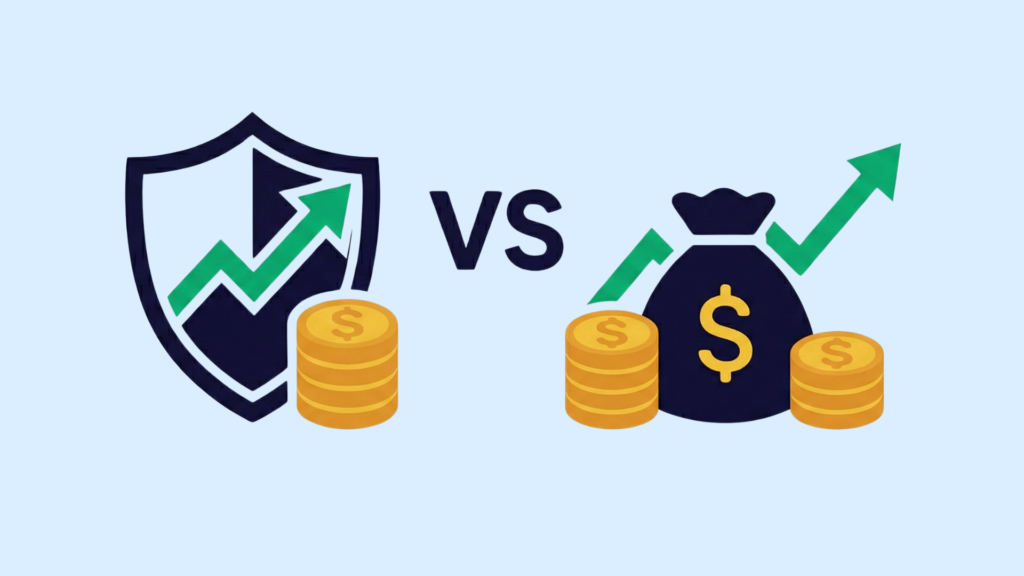TREPS (Tri-Party Repo) is a short-term borrowing instrument that plays a crucial role in managing liquidity within mutual funds. It allows funds to temporarily park surplus cash while earning stable, low-risk returns.
By using government securities as collateral, TREPS offers a secure way for mutual funds to meet redemption needs and optimise cash management. This helps maintain the fund’s efficiency, ensuring both liquidity and minimal risk exposure for investors.
What are TREPS in Mutual Funds?
TREPS is a short-term borrowing tool used in mutual funds. It involves three parties: the borrower, the lender, and a third party called the Tri-Party Agent, which is usually a clearing corporation.
Basically, the Tri-Party Agent acts as an intermediary, managing the collateral, payments, and settlement of the transaction. The agent also holds the securities until the agreement is completed.
Also Read: Direct vs Regular Mutual Funds | What is AMU in Mutual Funds?
TREPS Meaning in Mutual Funds
Tri-Party Repo (TREPS) is a short-term borrowing tool used in financial markets, particularly by mutual funds. In a TREPS arrangement, there are three parties involved: the borrower, the lender, and a Tri-Party Agent (usually a clearing corporation or custodian bank).
Moreover, the safety of TREPS comes from the fact that the transaction is secured by government securities. This collateral lowers the risk for the lender. Mutual funds use TREPS to park their extra funds overnight, earning a small return while maintaining liquidity and safety.
Also Read: Net Asset Value (NAV) in Mutual Fund | Interval Funds | Fixed Income Mutual Fund
How Does TREPS Work?
Here’s a detailed explanation of how TREPS work in mutual funds:
- The borrower sells government securities (such as treasury bills) to the lender in exchange for cash.
- The Tri-Party Agent acts as an intermediary, managing the transaction. This includes holding the securities as collateral, overseeing payments, and handling settlement.
- The borrower agrees to repurchase the securities at a later date for a slightly higher price, which includes the interest on the loan.
Since TREPS are backed by government securities and facilitated by a trusted intermediary, it is considered a low-risk investment. The system is also more transparent and efficient than previous alternatives, making it a safer choice for mutual funds to manage their short-term liquidity needs.
Also Read: What are Liquid Funds | Difference Between Stocks and Bonds
Why Mutual Funds Invest in TREPS
Mutual funds invest in TREPS for several strategic reasons, such as:
Liquidity Management
Mutual funds often have surplus cash that needs to be easily accessible. TREPS provides a solution by offering an overnight investment option. This allows mutual funds to park their idle cash temporarily while ensuring that the funds remain available for redemptions (when investors pull out their money). Since TREPS are short-term and highly liquid, they help funds manage cash flows without needing to sell other investments at unfavourable prices.
Risk Mitigation
The collateralised nature of TREPS—where government securities are used as collateral—greatly reduces credit risk. This means mutual funds face minimal risk of loss since the borrower has provided a safe asset to secure the transaction. Also, this makes TREPS a low-risk choice, which is especially attractive for funds prioritising capital preservation.
Portfolio Efficiency
By investing in TREPS, mutual funds can improve the efficiency of their portfolios. The interest earned from TREPS may be modest, but it provides a stable return on otherwise idle cash. This helps boost overall portfolio returns without taking on significant risk, especially when compared to other low-risk options like savings accounts.
Better Returns Than Savings Accounts
TREPS typically offer better returns than a savings account or other short-term instruments like fixed deposits. While they may not provide high returns, they are more attractive for mutual funds because they provide liquidity and a safe, stable return, making them a better option than leaving funds in a savings account, which offers lower interest.
Also Read: Hybrid Mutual Funds | Debt Mutual Funds | Lump Sum Mutual Funds
Key Features of TREPS in Mutual Funds
Now, let’s look at some key features that make TREPS an attractive choice for mutual fund portfolios.
Short-Term Investment Horizon
TREPS are typically overnight or short-term lending instruments. This makes them ideal for mutual funds looking to manage surplus cash temporarily while meeting short-term liquidity needs. Since the investment period is very short, funds can quickly access their cash without long-term commitment.
Low Credit Risk
TREPS transactions are collateralised with government securities. This means that if the borrower fails to repurchase the securities, the lender (in this case, the mutual fund) can sell the collateral to recover the funds. The use of government securities as collateral makes the risk of default extremely low.
Regulatory Oversight
The TREPS market is regulated by bodies such as the Securities and Exchange Board of India (SEBI). Clearing corporations also play an important role in overseeing and ensuring the smooth execution of these transactions. Their involvement adds a layer of security, ensuring that the market operates transparently and efficiently.
Market-Driven Rates
The interest rates on TREPS are determined by market conditions, meaning they reflect the supply and demand for short-term liquidity. As a result, the rates tend to be competitive, offering better returns than traditional savings accounts or other low-risk short-term instruments. These market-driven rates help mutual funds earn a modest but stable return on their idle cash.
Also Read: NFOs in Mutual Funds | Equity Mutual Funds | SIP Vs Mutual Fund
How TREPS Benefits Mutual Fund Investors
Here’s how TREPS can directly benefit mutual fund investors:
Enhanced Liquidity
Investing in TREPS helps mutual funds manage liquidity effectively. When mutual funds park their surplus cash in TREPS, they can easily access these funds if investors want to withdraw their money. This means mutual funds can handle redemptions smoothly without having to sell other investments or disrupt the fund’s performance.
Stable Returns on Idle Cash
Even when a mutual fund has cash that isn’t being invested, TREPS helps generate returns on that idle money. While the returns from TREPS might not be very high, they are consistent and predictable. This makes it an ideal option for mutual funds to earn some return on cash that would otherwise sit idle, improving the overall performance of the fund.
Lower Portfolio Volatility
Since TREPS are backed by government securities, they come with minimal credit risk. This helps reduce the overall volatility of the mutual fund, especially when market conditions are uncertain. Plus, it provides a safe way to balance more risky investments, making the fund less prone to large swings in value.
Also Read: Growth Mutual Funds | Income Fund | Type of Mutual Funds
Risks Associated with TREPS
While TREPS offers numerous advantages, it’s important to understand the potential risks involved, especially when mutual funds incorporate them into their investment strategies. Here are the key risks associated with TREPS:
Interest Rate Risk
TREPS transactions are influenced by short-term interest rates. When interest rates rise, the value of the underlying government securities may decrease. As a result, the returns from TREPS may be impacted, especially if the securities lose value due to interest rate changes.
Operational Risk
Although TREPS is generally considered a low-risk instrument, you need to consider operational risks. These risks can include mistakes during the execution or settlement of transactions, such as errors in collateral management or transaction processing. However, using a custodian bank or clearing corporation (which acts as an intermediary) significantly reduces these risks.
Also Read: ELSS Mutual Fund | How to Invest in Mutual Funds
TREPS vs. Other Short-Term Instruments
Let’s look at how TREPS compare with these other short-term instruments:
Comparison with Savings Accounts
TREPS generally offer better returns than savings accounts because they involve government securities as collateral, which adds a layer of security and earns higher interest.
While savings accounts provide a fixed, lower return, TREPS can provide higher returns based on market conditions, making them more appealing for mutual funds looking to grow idle cash.
Comparison with Fixed Deposits
Fixed deposits lock in your money for a predetermined period, which can make it harder to access the funds early without a penalty. In contrast, TREPS are highly liquid, typically lasting overnight or for a few days, allowing mutual funds to quickly access cash.
While both offer low risk, TREPS generally provide higher returns because their rates are linked to market movements, whereas FDs offer fixed returns that may be lower.
Comparison with Commercial Papers
Commercial papers are short-term debt instruments issued by companies, which carry a higher risk of default compared to government-backed securities used in TREPS. Also, since TREPS are backed by government securities and involve less credit risk, they tend to be more stable, making them a safer option.
Also Read: Corporate Bonds | What is CAGR in Mutual Funds | Mutual Fund Expense Ratio
How to Evaluate TREPS in Your Mutual Fund Portfolio
Now that you have a good grasp of what TREPS means and its advantages, here’s how you can evaluate TREPS in your mutual fund holdings:
Checking Allocation in Fund Portfolio
To assess how much TREPS is in your mutual fund holdings, review the fund’s investment details. Most mutual funds provide a breakdown of their assets, including the percentage allocated to TREPS. This information is typically available in the fund’s fact sheet or investment report.
Assessing Liquidity Needs
If you need quick access to your money, mutual funds with a higher allocation to TREPS can be more suitable. TREPS provide liquidity (easy access to cash) without disrupting the fund’s performance. Also, evaluate your own cash needs before choosing a fund with significant TREPS investments.
Balancing Risk and Returns
TREPS are low-risk, but they also offer modest returns. If you’re aiming for a stable, low-risk investment, a fund with a higher TREPS allocation may suit your goals. However, ensure your portfolio balances these low-risk investments with other assets that can offer higher returns, depending on your financial objectives.
Also Read: Close-ended Mutual Funds | Open-ended Mutual Funds | Mutual Fund Taxation
The Bottom Line
TREPS plays a key role in mutual funds by providing liquidity, reducing risk, and offering stable returns on idle cash. Its low-risk nature, backed by government securities, ensures that funds remain efficient while meeting redemption needs.
As an investor, it’s important to evaluate mutual fund options based on their TREPS allocation to ensure alignment with your financial goals. Appreciate, the best online trading app, can help guide your investment decisions by offering insights into funds with strategic TREPS investments, helping you make informed choices for your portfolio.
Download the Appreciate trading app now!
Also Read: How to Read Stock Market Charts | Dollar Cost Averaging
FAQs: TREPS in Mutual Funds
How does TREPS work in mutual funds?
TREPS (Tri-Party Repo) involves mutual funds lending cash to a borrower in exchange for government securities as collateral. The borrower agrees to repurchase the securities at a later date, typically overnight, allowing the mutual fund to earn interest on idle cash.
Why do mutual funds invest in TREPS?
Mutual funds invest in TREPS primarily for liquidity management and safety. These investments allow them to park cash temporarily while earning a small return, ensuring they have enough funds available for redemptions or other obligations.
Is TREPS a safe investment for mutual funds?
Yes, TREPS are generally considered safe because they are collateralised with government securities. This provides a layer of security, reducing the likelihood of loss even if the borrower defaults.
How does TREPS improve liquidity in mutual funds?
TREPS improve liquidity by offering a highly liquid investment option that can be easily converted to cash. This helps mutual funds meet redemption requests promptly without having to sell other assets at unfavourable prices.
What are the returns from TREPS compared to other instruments?
TREPS typically offer modest returns that are lower than riskier investments but higher than savings accounts. While the returns are stable, they are generally more competitive than other low-risk short-term instruments.
How do TREPS returns compare to savings accounts?
TREPS tend to offer higher returns than traditional savings accounts, as they are short-term investments with a collateralised nature. This makes them a better option for mutual funds looking to earn on idle cash without taking significant risk.
Can investors directly invest in TREPS?
No, individual investors cannot directly invest in TREPS. Only institutional investors, like mutual funds, are allowed to participate in these transactions.
How to evaluate the presence of TREPS in a mutual fund portfolio?
To evaluate the presence of TREPS in a mutual fund, review the fund’s portfolio report or fact sheet. It will indicate the types of assets held, including any short-term instruments like TREPS, and their proportion in the overall portfolio.
What is the role of clearing corporations in TREPS?
Clearing corporations ensure the smooth settlement of transactions between the lender and borrower by acting as intermediaries, guaranteeing the collateral and reducing operational risks in the process.
How does TREPS impact the overall performance of mutual funds?
TREPS impact mutual funds by providing stable, low-risk returns on idle cash, which can slightly boost overall performance. While the returns are not high, their role in liquidity management and risk reduction helps the fund maintain stability during volatile market conditions.
|
Here are more investment opportunities for stocks and shares that might interest you. |
|
Disclaimer: Investments in securities markets are subject to market risks. Read all the related documents carefully before investing. The securities quoted are exemplary and are not recommendatory.























